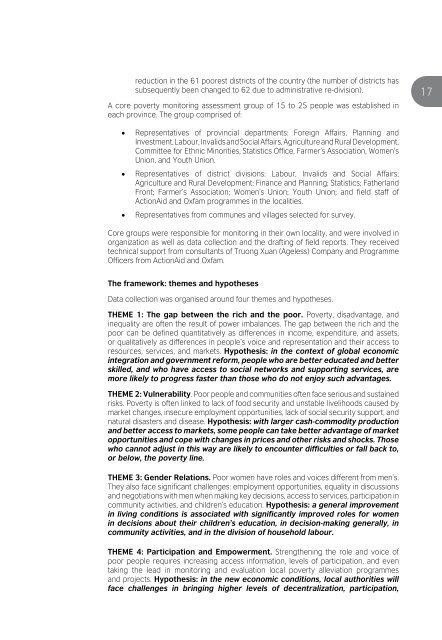Challenges to Rural Poverty Reduction in Viet Nam - Oxfam Blogs
Challenges to Rural Poverty Reduction in Viet Nam - Oxfam Blogs
Challenges to Rural Poverty Reduction in Viet Nam - Oxfam Blogs
Create successful ePaper yourself
Turn your PDF publications into a flip-book with our unique Google optimized e-Paper software.
eduction <strong>in</strong> the 61 poorest districts of the country (the number of districts has<br />
subsequently been changed <strong>to</strong> 62 due <strong>to</strong> adm<strong>in</strong>istrative re-division).<br />
A core poverty moni<strong>to</strong>r<strong>in</strong>g assessment group of 15 <strong>to</strong> 25 people was established <strong>in</strong><br />
each prov<strong>in</strong>ce. The group comprised of:<br />
17<br />
• Representatives of prov<strong>in</strong>cial departments: Foreign Affairs, Plann<strong>in</strong>g and<br />
Investment, Labour, Invalids and Social Affairs, Agriculture and <strong>Rural</strong> Development,<br />
Committee for Ethnic M<strong>in</strong>orities, Statistics Office, Farmer’s Association, Women’s<br />
Union, and Youth Union.<br />
• Representatives of district divisions: Labour, Invalids and Social Affairs;<br />
Agriculture and <strong>Rural</strong> Development; F<strong>in</strong>ance and Plann<strong>in</strong>g; Statistics; Fatherland<br />
Front; Farmer’s Association; Women’s Union; Youth Union; and field staff of<br />
ActionAid and <strong>Oxfam</strong> programmes <strong>in</strong> the localities.<br />
• Representatives from communes and villages selected for survey.<br />
Core groups were responsible for moni<strong>to</strong>r<strong>in</strong>g <strong>in</strong> their own locality, and were <strong>in</strong>volved <strong>in</strong><br />
organization as well as data collection and the draft<strong>in</strong>g of field reports. They received<br />
technical support from consultants of Truong Xuan (Ageless) Company and Programme<br />
Officers from ActionAid and <strong>Oxfam</strong>.<br />
The framework: themes and hypotheses<br />
Data collection was organised around four themes and hypotheses.<br />
THEME 1: The gap between the rich and the poor. <strong>Poverty</strong>, disadvantage, and<br />
<strong>in</strong>equality are often the result of power imbalances. The gap between the rich and the<br />
poor can be def<strong>in</strong>ed quantitatively as differences <strong>in</strong> <strong>in</strong>come, expenditure, and assets,<br />
or qualitatively as differences <strong>in</strong> people’s voice and representation and their access <strong>to</strong><br />
resources, services, and markets. Hypothesis: <strong>in</strong> the context of global economic<br />
<strong>in</strong>tegration and government reform, people who are better educated and better<br />
skilled, and who have access <strong>to</strong> social networks and support<strong>in</strong>g services, are<br />
more likely <strong>to</strong> progress faster than those who do not enjoy such advantages.<br />
THEME 2: Vulnerability. Poor people and communities often face serious and susta<strong>in</strong>ed<br />
risks. <strong>Poverty</strong> is often l<strong>in</strong>ked <strong>to</strong> lack of food security and unstable livelihoods caused by<br />
market changes, <strong>in</strong>secure employment opportunities, lack of social security support, and<br />
natural disasters and disease. Hypothesis: with larger cash-commodity production<br />
and better access <strong>to</strong> markets, some people can take better advantage of market<br />
opportunities and cope with changes <strong>in</strong> prices and other risks and shocks. Those<br />
who cannot adjust <strong>in</strong> this way are likely <strong>to</strong> encounter difficulties or fall back <strong>to</strong>,<br />
or below, the poverty l<strong>in</strong>e.<br />
THEME 3: Gender Relations. Poor women have roles and voices different from men’s.<br />
They also face significant challenges: employment opportunities, equality <strong>in</strong> discussions<br />
and negotiations with men when mak<strong>in</strong>g key decisions, access <strong>to</strong> services, participation <strong>in</strong><br />
community activities, and children’s education. Hypothesis: a general improvement<br />
<strong>in</strong> liv<strong>in</strong>g conditions is associated with significantly improved roles for women<br />
<strong>in</strong> decisions about their children’s education, <strong>in</strong> decision-mak<strong>in</strong>g generally, <strong>in</strong><br />
community activities, and <strong>in</strong> the division of household labour.<br />
THEME 4: Participation and Empowerment. Strengthen<strong>in</strong>g the role and voice of<br />
poor people requires <strong>in</strong>creas<strong>in</strong>g access <strong>in</strong>formation, levels of participation, and even<br />
tak<strong>in</strong>g the lead <strong>in</strong> moni<strong>to</strong>r<strong>in</strong>g and evaluation local poverty alleviation programmes<br />
and projects. Hypothesis: <strong>in</strong> the new economic conditions, local authorities will<br />
face challenges <strong>in</strong> br<strong>in</strong>g<strong>in</strong>g higher levels of decentralization, participation,

















